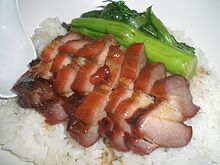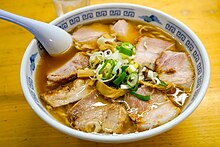 A rack of cha siu pork A rack of cha siu pork | |
| Alternative names | chasu, char siu, chashao, cha sio, char siew (Cantonese), chāshū (Japanese), xá xíu (Vietnamese) |
|---|---|
| Place of origin | Guangdong, China |
| Region or state | Greater China, Japan and Singapore (and general Sinophone areas in Southeast Asia and beyond) |
| Main ingredients | Pork, mixture of honey, five-spice powder, fermented tofu (red), dark soy sauce, hoisin sauce, and sherry or rice wine |
| Char siu | |||||||||||||||||||||||||
|---|---|---|---|---|---|---|---|---|---|---|---|---|---|---|---|---|---|---|---|---|---|---|---|---|---|
 "Char siu" in Traditional (top) and Simplified (bottom) Chinese characters "Char siu" in Traditional (top) and Simplified (bottom) Chinese characters | |||||||||||||||||||||||||
| Chinese name | |||||||||||||||||||||||||
| Traditional Chinese | 叉燒 | ||||||||||||||||||||||||
| Simplified Chinese | 叉烧 | ||||||||||||||||||||||||
| Jyutping | caa1 siu1 | ||||||||||||||||||||||||
| Hanyu Pinyin | chāshāo | ||||||||||||||||||||||||
| Literal meaning | "fork roasting" | ||||||||||||||||||||||||
| |||||||||||||||||||||||||
| Vietnamese name | |||||||||||||||||||||||||
| Vietnamese | xá xíu | ||||||||||||||||||||||||
| Thai name | |||||||||||||||||||||||||
| Thai | หมูแดง [mǔː dɛ̄ːŋ] | ||||||||||||||||||||||||
| RTGS | mu daeng | ||||||||||||||||||||||||
| Korean name | |||||||||||||||||||||||||
| Hangul | 차시우 | ||||||||||||||||||||||||
| |||||||||||||||||||||||||
| Japanese name | |||||||||||||||||||||||||
| Kanji | 叉焼 | ||||||||||||||||||||||||
| Kana | チャーシュー | ||||||||||||||||||||||||
| |||||||||||||||||||||||||
| Indonesian name | |||||||||||||||||||||||||
| Indonesian | babi panggang merah / Cha Sio | ||||||||||||||||||||||||
| Khmer name | |||||||||||||||||||||||||
| Khmer | សាច់ជ្រូកអាំង | ||||||||||||||||||||||||
Char siu (Chinese: 叉燒; Cantonese Yale: chāsīu) is a Cantonese-style barbecued pork. Originating in Guangdong, it is eaten with rice, used as an ingredient for noodle dishes or in stir fries, and as a filling for cha siu bao or pineapple buns. Five-spice powder is the primary spice, honey or other sweeteners are used as a glaze, and the characteristic red color comes from the red yeast rice when made traditionally.
It is classified as a type of siu mei (燒味), Cantonese roasted meat.
Meat cuts
Pork cuts used for char siu can vary, but a few main cuts are common:
- Pork loin
- Pork belly – produces juicy and fattier char siu
- Pork butt (shoulder) – produces leaner char siu
- Pork fat
- Pork neck end – very marbled (jyu geng yuk)
Cultural variations
Cantonese cuisine

Char siu literally means "fork roasted" (siu being burn/roast and cha being fork, both noun and verb) after the traditional cooking method for the dish: long strips of seasoned boneless pork are skewered with long forks and placed in a covered oven or over a fire.
In ancient times, wild boar and other available meats were used to make char siu. However, in modern times, the meat is typically a shoulder cut of domestic pork, seasoned with a mixture of honey, five-spice powder, red fermented bean curd, dark soy sauce, hoisin sauce, red food colouring (not a traditional ingredient but very common in today's preparations and is optional), and sherry or rice wine (optional). These seasonings turn the exterior layer of the meat dark red, similar to the "smoke ring" of American barbecues. Maltose may be used to give char siu its characteristic shiny glaze.
Char siu is typically consumed with a starch, whether inside a bun (cha siu bao, 叉燒包), with noodles (chasiu min, 叉燒麵), or with rice (chasiu faan, 叉燒飯) in fast food establishments, or served alone as a centerpiece or main dish in traditional family dining establishments. If it is purchased outside of a restaurant, it is usually taken home and used as one ingredient in various complex main courses consumed at family meals.
The ovens used to roast char siu are usually large gas rotisseries. Since ovens are not standard in Hong Kong households, char siu is usually purchased from a siu mei establishment, which specialises in meat dishes such as char siu, soy sauce chicken, white cut chicken, roasted goose, and roasted pork. These shops usually display the merchandise by hanging them in the window.
Southeast Asian cuisine

In Malaysia, Singapore, Indonesia, Cambodia, Thailand, and Vietnam, char siew rice is found in many Chinese shāolà (烧腊) stalls along with roast duck and roast pork. The dish consists of slices of char siu, cucumbers, white rice and is drenched in sweet gravy or drizzled with dark soy sauce. Char siu rice is also a popular food within the Chinese community in Medan, North Sumatra, where it is more called char sio.
In Singapore, char siew rice can also be found in Hainanese chicken rice stalls, where customers have a choice of having their char siu rice served with plain white rice or chicken-flavoured rice, and choose from garlic, chilli and soy sauces.
In Thailand, char siu is called mu daeng (Thai: หมูแดง, pronounced [mǔː dɛ̄ːŋ], "red pork") and in Cambodia it is called sach chrouk sa seev (Khmer: សាច់ជ្រូកសាស៉ីវ, sac cruuk sa səyv).
In the Philippines, it is known as Chinese pork asado, but also referred to as cha siu. It is usually eaten with cold cuts or served stuffed in siopao.
In Flanders and Holland, it is sometimes mistaken for the Chinese/Indonesian name 'babi pangang'. This is a different dish (mostly sweeter and served with yellow pickled Chinese cabbage, called atjar). In fact, these Chinese/Indo restaurants serve cha(r) sieuw under the original name. These restaurants in the Netherlands derived from Chinese immigrants and are made to adapt to the Dutch palate.
Vegetarian char siu also exists, usually made from wheat gluten. It can be found in vegetarian restaurants and stalls in South East Asian Chinese communities.
Japanese cuisine

Japanese culture has adapted 叉燒 as chāshū (チャーシュー). Unlike its Chinese variant, it is prepared by rolling pork belly into a log and then braising it at a low temperature. The Japanese adaptation is typically seasoned with soy sauce, sake, mirin and sugar or other sweetener, without the red food colouring, nor five-spice powder. It is a typical ingredient for toppings in rāmen.
Korean cuisine
Gochujang chasiu (차시우) is roast pork belly with a unique fusion of Chinese and Korean flavors. It is sticky and sweet from the sugar and honey, smoky from the aromatic Chinese spices, and subtly spicy from the Korean gochujang. Sometimes, chasiu is used in bibimbap.
Pacific Rim cuisine
| This section does not cite any sources. Please help improve this section by adding citations to reliable sources. Unsourced material may be challenged and removed. (December 2022) (Learn how and when to remove this message) |
As a means of exceptional flavor and preparation, char siu applications extend beyond pork. In Hawaii, various meats are cooked char siu style. The term char siu refers to meats which have been marinated in char siu seasoning prepared either from scratch or from store-bought char siu seasoning packages, then roasted in an oven or over a fire. Ingredients in marinades for cha siu are similar to those found in China (honey, five-spice, wine, soy, hoisin, etc.), except that red food colouring is often used in place of the red bean curd for convenience. Char siu is used to marinate and prepare a variety of meats which can either be cooked in a conventional or convection oven (often not requiring the use of a fork or cha(zi) as traditional Chinese ovens do), on a standard barbecue, or even in an underground Hawaiian imu. In Hawaii, char siu chicken is as common as char siu pork, and various wild birds, mountain goat, and wild boar are also often cooked char siu style, as are many sausages and skewers.
See also
References
- "Siu Mei Kung Fu". RTHK. Retrieved 1 February 2015.
- "Chinese BBQ pork (char siu) 蜜汁叉燒". Graceful Cuisine. 7 January 2012. Archived from the original on 2 February 2013. Retrieved 9 February 2013.
- ^ AsianCookingMom (6 June 2020). "Japanese Chashu Pork". Asian Cooking Mom. Retrieved 18 October 2022.
- "The Ultimate Chinese Barbecue Guide". The Manual. 8 June 2021. Retrieved 26 September 2021.
- ^ Deutsch, Jonathan; Elias, Megan J. (15 April 2014). Barbecue: A Global History. Reaktion Books. p. 52. ISBN 978-1-78023-298-0.
- Sinclair, Charles Gordon (1998). International Dictionary of Food and Cooking. Taylor & Francis. p. 115. ISBN 978-1-57958-057-5.
- De Leon, Adrian (1 May 2016). "Siopao and Power: The Place of Pork Buns in Manila's Chinese History". Gastronomica. 16 (2): 45–54. doi:10.1525/gfc.2016.16.2.45. ISSN 1529-3262.
- Jimura, Takamitsu (16 August 2021). Cultural Heritage and Tourism in Japan. Routledge. ISBN 978-0-429-67163-0.
| Articles | |||||||
|---|---|---|---|---|---|---|---|
| Dishes |
| ||||||
| Snacks and desserts | |||||||
| Drinks | |||||||
| Common dishes |
| ||||||||||||
|---|---|---|---|---|---|---|---|---|---|---|---|---|---|
| Snacks |
| ||||||||||||
| Desserts | |||||||||||||
| Drinks |
| ||||||||||||
| Condiments | |||||||||||||
| Individual dishes | |
|---|---|
| Shared dishes | |
| Isan dishes | |
| Northern Thai dishes | |
| Southern Thai dishes | |
| Snacks |
|
| Desserts |
|
| Miscellaneous |
|
| Beverages | |
| See also | |
| Guangdong topics | |
|---|---|
| Guangzhou (capital) | |
| General | |
| Geography |
|
| Education | |
| Culture |
|
| Cuisine | |